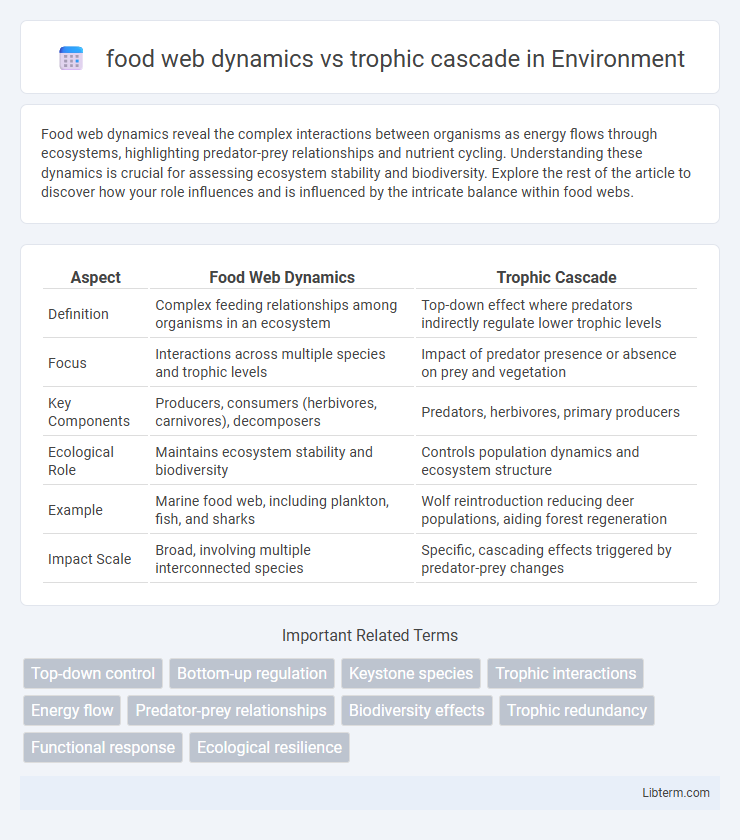Food web dynamics reveal the complex interactions between organisms as energy flows through ecosystems, highlighting predator-prey relationships and nutrient cycling. Understanding these dynamics is crucial for assessing ecosystem stability and biodiversity. Explore the rest of the article to discover how your role influences and is influenced by the intricate balance within food webs.
Table of Comparison
| Aspect | Food Web Dynamics | Trophic Cascade |
|---|---|---|
| Definition | Complex feeding relationships among organisms in an ecosystem | Top-down effect where predators indirectly regulate lower trophic levels |
| Focus | Interactions across multiple species and trophic levels | Impact of predator presence or absence on prey and vegetation |
| Key Components | Producers, consumers (herbivores, carnivores), decomposers | Predators, herbivores, primary producers |
| Ecological Role | Maintains ecosystem stability and biodiversity | Controls population dynamics and ecosystem structure |
| Example | Marine food web, including plankton, fish, and sharks | Wolf reintroduction reducing deer populations, aiding forest regeneration |
| Impact Scale | Broad, involving multiple interconnected species | Specific, cascading effects triggered by predator-prey changes |
Introduction to Food Web Dynamics
Food web dynamics describe the complex interactions and energy flow between multiple species within an ecosystem, illustrating how changes in population sizes influence biodiversity and ecosystem stability. Trophic cascades occur when alterations at one trophic level, such as predator removal, trigger cascading effects across lower or higher trophic levels, affecting primary producers and herbivores. Understanding food web dynamics is essential for predicting ecological responses to disturbances and managing ecosystem health.
Defining Trophic Cascades
Trophic cascades describe indirect interactions that control entire ecosystems, occurring when predators suppress the abundance of their prey, thereby releasing the next lower trophic level from predation or herbivory. Food web dynamics encompass complex feeding relationships among multiple species across various trophic levels, highlighting energy flow and nutrient cycling. While trophic cascades focus specifically on how changes at one trophic level propagate through others, food web dynamics capture the broader network of biotic interactions shaping ecosystem stability.
Key Differences Between Food Webs and Trophic Cascades
Food web dynamics illustrate complex interactions among multiple species across various trophic levels, emphasizing energy flow and nutrient cycling in ecosystems. In contrast, trophic cascades represent a linear chain of effects triggered by changes in predator populations that indirectly influence lower trophic levels, often resulting in population fluctuations or behavioral shifts. Key differences include the multidirectional relationships in food webs versus the unidirectional cause-and-effect sequence in trophic cascades, highlighting the varying degrees of ecosystem impact and complexity.
Complexity of Interactions in Food Webs
Food web dynamics encompass the intricate network of species interactions, including predation, competition, and mutualism, which create multiple feedback loops across various trophic levels. Trophic cascades specifically describe the ripple effects originating from changes in predator populations that propagate down through lower trophic levels, altering ecosystem structure and nutrient cycling. The complexity of interactions in food webs, involving omnivory, intraguild predation, and nonlinear responses, often modulates or buffers the strength and predictability of trophic cascades.
Top-Down vs Bottom-Up Controls
Top-down controls in food web dynamics emphasize predator effects on prey populations, regulating the abundance and distribution of lower trophic levels and potentially initiating trophic cascades that propagate through ecosystems. Bottom-up controls focus on nutrient availability and primary productivity, driving population sizes and community structure from the base of the food web upward. Understanding the interaction between these controls is essential for predicting ecosystem responses to environmental changes and managing biodiversity effectively.
Examples of Trophic Cascade Events
The reintroduction of wolves to Yellowstone National Park triggered a trophic cascade that restored vegetation and stabilized elk populations, exemplifying the profound impact apex predators have on food web dynamics. In marine ecosystems, overfishing of predatory fish like sharks has led to an increase in mid-level predators such as rays, which in turn caused a decline in shellfish populations, demonstrating a trophic cascade effect. Similarly, the removal of sea otters from kelp forests resulted in sea urchin population explosions, decimating kelp and altering the entire habitat structure.
Human Impacts on Food Web Stability
Human activities such as deforestation, pollution, and overfishing disrupt food web dynamics by altering species interactions and energy flow across multiple trophic levels. These disturbances often trigger trophic cascades, where changes in apex predator populations cascade down to affect primary producers and overall ecosystem functioning. Understanding how anthropogenic impacts destabilize food webs is crucial for developing conservation strategies that preserve biodiversity and ecosystem resilience.
Role of Keystone Species in Food Webs
Keystone species play a critical role in food web dynamics by maintaining the balance and stability of ecosystems through their disproportionate influence on trophic interactions. Their removal can trigger trophic cascades, leading to significant changes in population sizes across multiple trophic levels and altering ecosystem structure. Understanding keystone species is essential for predicting and managing the cascading effects within complex food webs.
Ecosystem Resilience and Cascade Effects
Food web dynamics reveal complex interactions among multiple species, contributing to ecosystem resilience by maintaining biodiversity and ecological functions even when disturbances occur. Trophic cascades involve top predators influencing lower trophic levels, triggering cascade effects that can significantly alter ecosystem structure and nutrient cycling. Understanding these processes is essential for predicting ecosystem responses to environmental changes and implementing effective conservation strategies.
Implications for Conservation and Management
Understanding food web dynamics reveals complex species interactions influencing ecosystem stability, whereas trophic cascades highlight the top-down effects predators exert on lower trophic levels. Incorporating both concepts into conservation strategies enhances ecosystem resilience by maintaining predator populations and preserving biodiversity. Effective management requires monitoring species interactions to prevent cascading effects that could disrupt ecological balance and reduce habitat quality.
food web dynamics Infographic

 libterm.com
libterm.com